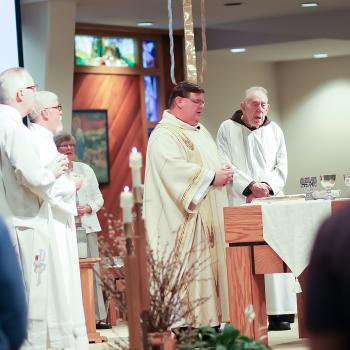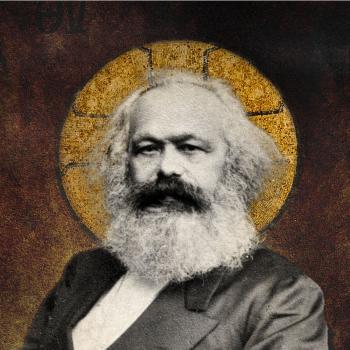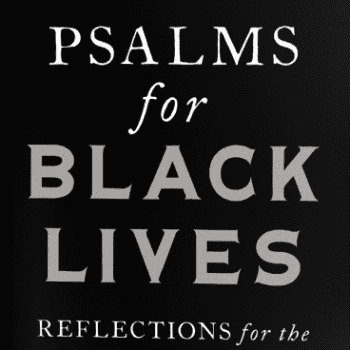 Easter morning approaches, bringing with it a fresh opportunity — and challenge — to unpack the mystery of the Resurrection to an alternately curious, skeptical and hopeful world. Here’s how a few of our Patheos bloggers plan to preach it this Sunday.
Easter morning approaches, bringing with it a fresh opportunity — and challenge — to unpack the mystery of the Resurrection to an alternately curious, skeptical and hopeful world. Here’s how a few of our Patheos bloggers plan to preach it this Sunday.
[Let us know how you’re planning to preach (or would preach) the Resurrection in the Comments section below.]
Christian Piatt
Bending Toward Love
Lots of folks love preaching about the risen Christ on Easter Sunday without talking about what he went through to get there. It’s a bad habit we Protestants have, but plenty of us skip right over Maundy Thursday and Good Friday to Easter. Part of this is because we don’t like to have to deal with the darkness of Jesus crucifixion, suffering, death and burial, but it’s also because we don’t really understand the resurrection.
For me, resurrection is a process, rather than a one-time event. It’s more like how Martin Luther King spoke of history’s arc, bending toward justice. God’s arc for the whole of humanity is long, chaotic and sometimes even violent. But it bends toward hope. It bends toward life and love. That love, though not yet fully realized, is a restoring love that is greater than the sum total of the destructive forces humanity can muster.
Resurrection literally means to make something right again. Though we are bent, bruised and bloodied by life’s darkness, God’s love makes us upright once again. Maybe not today. Maybe not tomorrow. But faith in resurrection means that our entire existence bends toward God’s fullness.
 Chris Piatt is creator and editor of Banned Questions about the Bible and Banned Questions About Jesus. His memoir, PREGMANCY: A Dad, a Little Dude and a Due Date, comes out next month. Christian blogs at Father, Son and Holy Heretic.
Chris Piatt is creator and editor of Banned Questions about the Bible and Banned Questions About Jesus. His memoir, PREGMANCY: A Dad, a Little Dude and a Due Date, comes out next month. Christian blogs at Father, Son and Holy Heretic.
Elizabeth Nordquist
 I would preach Easter this year as the Quiet Revolution. I am reading Susan Cain’s insightful new book, Quiet, which demonstrates the power of the introvert, and chronicles the deep changes that can be made in quiet and confidence, rather than by the brass quartets and mass choirs that our culture celebrates. The quintessential Easter story for me is in John 20:11-18, where three quiet movements underlie the earthshaking and radical shift that the resurrection of Jesus brings.
I would preach Easter this year as the Quiet Revolution. I am reading Susan Cain’s insightful new book, Quiet, which demonstrates the power of the introvert, and chronicles the deep changes that can be made in quiet and confidence, rather than by the brass quartets and mass choirs that our culture celebrates. The quintessential Easter story for me is in John 20:11-18, where three quiet movements underlie the earthshaking and radical shift that the resurrection of Jesus brings.
First, Jesus comes to Mary as a complete surprise, alone, unrecognizable at first. Yet all the rules of the universe have been changed. Far away from the chanting crowds of Friday, this huge sea change is intimate, but deep. Furthermore, Jesus demands that we learn to love and follow him in a new and different way. “Don’t hang on,” he tells Mary. Easter challenges us to keep learning who the Holy One is, with an expanding repertoire of trust and care.
Moreover, the resurrection mandates that Mary participate by going and telling, sharing this new reality with the community. Even though this Easter is quiet, it is not private; it is good news for the world that God love. Across the background of shrill and clanging noises of our geopolitical world, the quiet revolutionary act of God in the resurrection changes everything and gives us hope and energy for our lives in this world and the next.
Elizabeth Nordquist is a pastor, a teacher, a spiritual director, a family lover and a friend. She blogs at A Musing Amma.
Monica A. Coleman
 The story does not end with crucifixion.
The story does not end with crucifixion.
That’s the message I need to hear this Easter. In the last weeks, wider America has become more conscious of what African Americans have always known: crucifixion can happen at any moment. When pulled over by the police, when walking home, when shopping for Skittles and iced tea. As parents, we teach our children how to walk, talk, dress, move their eyes and place their hands on a steering wheel in meager hopes that the prejudice of the empowered will not kill them.
The case of Trayvon Martin causes us to remember the many crucified innocents: Emmett Till,Amadou Diallo, Jordan Martin, Kenneth Chamberlain, and far too many others African American boys and men.
They stand in the same vein as Jesus, the crucified innocent of our faith.
I need to be reminded that the crucifixion does not save us; the resurrection does.
The resurrection reminds us that the story does not end in slaughter. There is life after death. This year the crucifixion asks us where we will find the risen Christ. Where will we find life after death? How will we make meaning out of tragedy?
I hope to find Easter in the raised consciousness and solidarity among those who recognize discrimination when they see it. I hope to find Easter in the protests and rallies. I hope to find Easter in justice.
Monica A. Coleman is Associate Professor of Constructive Theology and African American Religions at Claremont School of Theology and the author or co-editor of 4 books including the recent Not Alone: Reflections on Faith and Depression. She blogs at www.BeautifulMindBlog.com.
 Instead of the lectionary text, I feel drawn to the next chapter in which Jesus appears to the disciples by the Sea of Tiberias. Just as Jesus is made known “in the breaking of the bread” on the road to Emmaus (Luke 24), we are invited to see how Jesus’ presence may be experienced on a beach with friends, while roasting fish over a charcoal fire. After breaking bread together and experiencing such a Communion, our post-Resurrection challenge is to “Feed my lambs”: to feed those who are hungry, in body and spirit, as we have been graciously fed.
Instead of the lectionary text, I feel drawn to the next chapter in which Jesus appears to the disciples by the Sea of Tiberias. Just as Jesus is made known “in the breaking of the bread” on the road to Emmaus (Luke 24), we are invited to see how Jesus’ presence may be experienced on a beach with friends, while roasting fish over a charcoal fire. After breaking bread together and experiencing such a Communion, our post-Resurrection challenge is to “Feed my lambs”: to feed those who are hungry, in body and spirit, as we have been graciously fed.
Read Carl’s complete “Practice Resurrection” post here.
Carl Gregg is the pastor of Broadview Church in Chesapeake Beach, Maryland. He blogs at Pluralism, Progressivism, Pragmatism: A Protestant Pastor in a Postmodern World.
David Henson
A Homily For Easter
Goddamn evil
Goddamn abuse
Goddamn injustice, slavery and rape.
Goddamn racism
Goddamn war
Goddamn that strange fruit of bigotry and hate
Goddamn suffering
Goddamn hunger
Goddamn indifference, apathy and waste
Goddamn noose
Goddamn death
Goddamn despair, depression, the wait
Goddamn Good Friday
And a Goddamn cross
Goddamned it all,
Goddamned it too late
Yet we live like it’s Easter
Like God has been raised
We live like it’s light,
In spite of the dark.
We live like there’s joy
With spite in our hearts
For all that remain of our Goddamned days
These Goddamned
Good Fridays.
 David Henson is a postulant for the priesthood in the Episcopal Church and is writing his first book. He blogs at Edges of Faith. Check out his post on Protesting Holy Week here.
David Henson is a postulant for the priesthood in the Episcopal Church and is writing his first book. He blogs at Edges of Faith. Check out his post on Protesting Holy Week here.
Bruce Epperly
 This year I’m spending Holy Week in Bethany Beach, Delaware, taking a much needed Sabbath with my family. In the course of the week, I will be spreading my brother’s ashes along the Atlantic Coast. The interplay of life and death will be present as I let go of my brother and prepare to welcome my second grandchild. As Howard Thurman says, “all around us worlds are dying and new worlds are being born.” Our world is perpetually perishing, yet new life is constantly emerging.
This year I’m spending Holy Week in Bethany Beach, Delaware, taking a much needed Sabbath with my family. In the course of the week, I will be spreading my brother’s ashes along the Atlantic Coast. The interplay of life and death will be present as I let go of my brother and prepare to welcome my second grandchild. As Howard Thurman says, “all around us worlds are dying and new worlds are being born.” Our world is perpetually perishing, yet new life is constantly emerging.
As I ponder the Easter story, recorded in Mark 16:1-8, I am struck by the women’s question: “Who will roll away the stone for us?” There are many stones that stand in the way of our futures, and we can’t roll them away on our own. We need a quantum leap of energy, inspiration, and love; the sort of resurrection that can only emerge in a faithful community, attentive to God’s transforming presence.
Resurrection will always be a mystery. But, we know it when it happens. Mark’s resurrection story (Mark 16:1-8) ends with the women in awe, fear, and silence. Resurrection is too much to comprehend when we assume the finalities of death and defeat. But, the empty tomb portends an open future in which the Risen One goes ahead us as companion, guide, and inspiration. While I don’t worry about the mechanics of the resurrection, I believe that Jesus lives – I have seen resurrection in unexpected courage and surprising love; in the face of my grandson, the child of a cancer survivor; in willingness to sacrifice for a great cause; and in the persistent quest for justice despite the odds. I believe that Christ is alive and in his resurrection, we can face the future with strength, courage, and wisdom as we take our place as God’s partners in healing the earth.
Bruce Epperly is a theologian, pastor, and author of 22 books, including Process Theology: A Guide for the Perplexed and Holy Adventure: 41 Days of Audacious Living. He blogs at Living A Holy Adventure.
Sam Alexander

Other years I’ve spent time worrying over what happened on Easter morning, but not this year. This year I want to know what it means, particularly through the eyes of Mary Magdalene in the 20th chapter of John. The text says she saw, (theorein), Jesus and the Angels – but that verb isn’t about ordinary seeing. No, it is the kind of seeing that dawns on you, a seeing that leads you to grasp hold of something and let it move you to action. That’s action in a world where we expect so little from each other – so little action, so little character, and virtually no unique contribution to the greater good – except of course from our public figures. Should they fall short of some puritanical expectation, they are crucified, (fortunately not literally any more), as though such a sacrifice might make things right with the world. That’s instead of living out the Divine expectation for our lives.
My Lent preaching has focused on the Tabernacle – the tent in the wilderness where the Israelites came to see, (theorein I would imagine), God. We saw, (theorein), offerings that drew the people into a coherent whole, new life drawn out of the basin, the lampstand that sheds light on something beyond ourselves, and in the midst of it all, we saw, (theorein), the image of God as though the boundary between sacred and created order was ephemeral, fluid, inviting us into life in the presence of God. “And the logos became flesh and tabernacled among us,” John says, so that boundary is forever obscured for all to see, (theorein), . . . and we sacrificed him as though such a sacrifice might make things right with the world.
Well, God rejected our sacrifice on Easter morning. God raised Jesus from the dead and this new vision of humanity, called Mary’s name, inviting her to live her life, her unique life oriented toward the God of all creation. We expect so little from each other, so much more is possible. The boundary between sacred and created order is fluid; the Word of God is alive within and around us. Can you see, (theorein), it?
Sam Alexander is Pastor of First Presbyterian Church of San Rafael, CA and an adjunct professor at San Francisco Theological Seminary. He blogs at www.gracecomesfirst.net and starts a new blog at Patheos next month called Christianity for the Spiritual But Not Religious.












